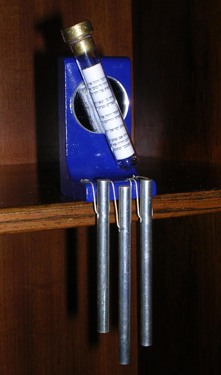|
|
Religious Articles for "And these words, which I command thee this day, shall be upon thy heart...and thou shalt bind them for a sign upon thy hand, and they shall be for frontlets between thine eyes. And thou shalt write them upon the door-posts of thy house, and upon thy gates." Deuteronomy 6:6-9 |
|
|
Several years ago I began making Mazuzoth for myself. Then I started making them for others. This I did because I deduced, from passages such as Deuteronomy 6:6-9, that the LORD really did want us to remind ourselves continually of His Word. Consequently, in all my religious objects, the Word is clearly visible. This Word is supposed to be bound to our arms, our heads and our doors. Although Jews comply with these commandments, they do so in a manner which is almost surely different from that which was originally intended. The Words on the arm, and on the head, undoubtedly referred respectively to the wearing of ornamental bracelets, and to decorations for the turban or other head covering worn in the Middle East in biblical times. Presumably, people were already wearing such decorative ornaments before Moses, but containing pagan words and/or symbols. Moses simply wanted those symbols replaced with decorations containing the Words of the LORD only. Although there was only consensus, and never complete agreement, concerning which of the LORD's Words were to be thusly bound and exalted, the basic nature of the commandment was clear. In modern "traditional" Judaism, the commandment to wear the Words on the arm and head are fulfilled by T'fillin, blocks of wood attached to those organs by leather straps. The words are inside the blocks, and cannot be seen. The blocks are generally worn only during morning prayers, then are removed. I've always suspected that the arm Mazuzah, whatever form Moses intended it to take, was supposed to be worn continuously, not just during morning prayers. And it's my opinion that the Words should be visible. (My solution is the wristwatch Mazuzah, which you will see below). The commandment to bind the Words to the door is fulfilled by the modern-day door Mazuzah, which contains the Words in a scroll, placed inside a highly-decorative casing. Most people think the casing is the Mazuzah, but the casing is superfluous. The Mazuzah is the scroll itself, which, as in the T'fillin, is once again invisible. Furthermore, the casing is often very expensive, not infrequently being made of precious metals encrusted with jewels. It draws attention away from the contents within. When, as a 40-year-old adult studying Torah for the first time, I found out that the Mazuzah was actually the scroll, I began to make my own ornaments for the arm, head and door. They were, and still are, very simple in design, and they reveal the scroll above all else. Two examples of door Mazuzoth are shown above. Here is what I wear on my arm, whenever I leave my house:
And here is an example of a more elaborate Mazuzah for the door:
Click to read Mazuzah text and specifications.
Ken Biegeleisen * * *
|



